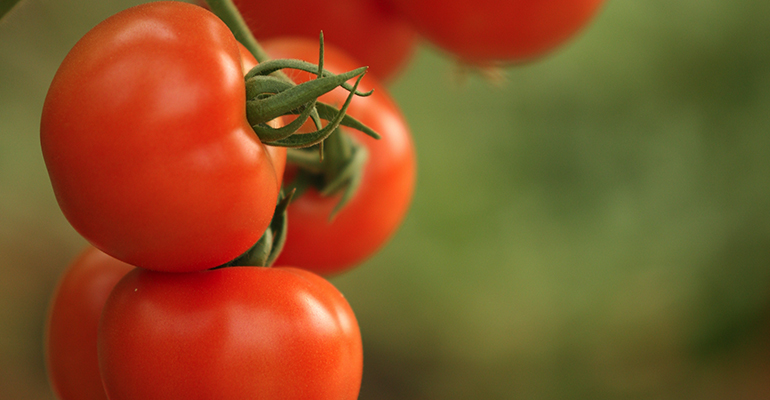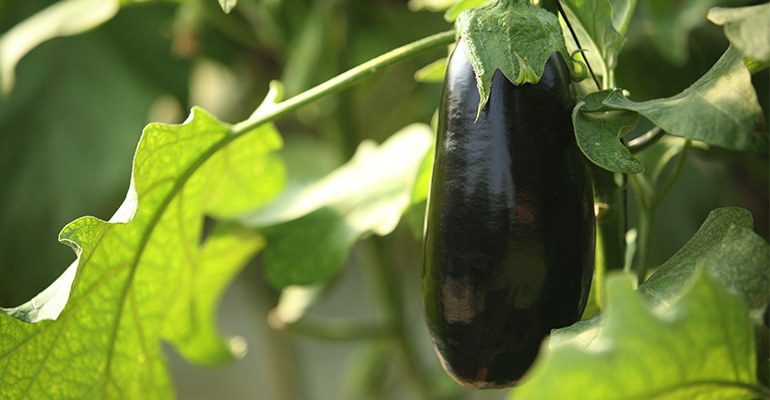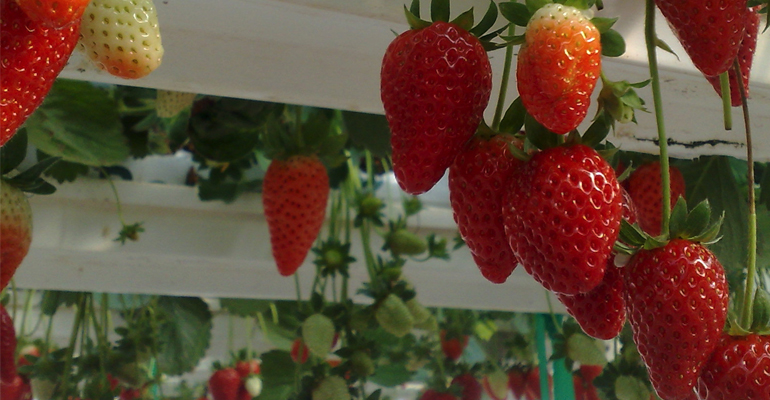Vegetables
The vegetable sector in the Central and Northern Arava accounts for about 75% of total crops. The major crop is currently bell peppers. The R&D in the vegetables sector focuses on pepper, but there is also research conducted on tomatoes, eggplant, melon, strawberry and other crops.
Main studies:
- Examination of crops and new varieties, improved agro-technics - Evaluation of potential yield and fruit quality.
- Efficient use of water and fertilizer in different water qualities - Studying means of irrigation and fertilization control using tensiometers and various sensors (humidity, salinity).
Reducing the levels of nitrogen fertilizers and soil contamination. - Dealing with the shortage of arable land - Developing alternative ways of growing in infertile soil, using different substrates and ditches.
- Studying means for reducing production costsNo tilling, streamlining picking through automation, improving Agro-technics of pepper and eggplant, improving methods of data collection.
- Ecological aspects - sustainable agriculture - The use of compost produced from local agricultural waste for animal feed and as agricultural substrates.
- Solar Greenhouse - Growing vegetables under a novel greenhouse model, which combines agriculture with electricity production.
Management

Shimon Pivonia, Ph.D.
Researcher, Coordinator
Team

Shabtai Cohen
Advisor, Researcher

Yoram Zvieli
Advisor, Researcher

Adi Suisa
Advisor, Researcher

Moti Osherovich
Technician
Contact
Recent Reports
-
12yearsago
“Agricultural Oasis” A pilot-scale nanofiltration desalination system for growing in Arid zone
Vegetables"Agricultural Oasis" A pilot-scale nanofiltration desalination system for growing in Arid zone
Rami Messalem and Andrea Ghermandi - Zuckerberg Institute for Water Research Ben-Gurion University of the Negev
Shabtai Cohen, Rivka Offenbach, Avi Usherovitz, Dorit Hashmonai, Yuval Barzilai - Central and Northern Arava R&D
Writer address: ghermand@bgu.ac.ilA pilot-scale agricultural facility aimed at the environmentally sustainable production of staple crops in arid environments was built and tested at the Yair agricultural research station in Hatzeva, Israel. The facility relies on a pilot plant utilizing nanofiltration (NF) membranes for the desalination of the local brackish water and production of high-quality irrigation water. During the first project year, the desalination unit was run on grid electricity, but solar photovoltaic (PV) modules were installed in May 2011 with the purpose of achieving full energy autonomy during the second project year. The potential costs for brine disposal in inland desalination are turned to an advantage by growing red beet with the brine waste product, a salt-tolerant crop with a high nutritional value.
Agricultural experiments with different staple crops were conducted over two growing seasons. Experimental plots irrigated with desalinated water and control plots irrigated with brackish water were cultivated with potatoes during the winter cycle, between November 2010 and March 2011. Maize, millet and sorghum were grown during the spring cycle between March and June 2011. During both cycles, crops irrigated with desalinated water consistently received 25% less irrigation volumes than the control plots.
The NF desalination unit operated according to expectations and with only one significant interruption due to a pump malfunction over the whole period. It exceeded the expectations regarding permeate flow (6.5 m3/d) and specific energy consumption (1.37 kWh/m3). It was consistently operated at the low pressure of 4.3 bar. The permeate water produced after blending with a fraction of the feed water has a moderate electrical conductivity (0.86 dS/m) and contains concentrations of the plant micronutrients calcium (45 ppm) and magnesium (23 ppm), which are above the minimum recommended for use of desalinated water in agriculture. The use of NF desalination is shown to provide substantial advantages for agricultural application with respect to reverse osmosis in terms of lower operating pressure and energy consumption.
The analysis of the produce from the cultivation of potatoes during the winter cycle shows no significant differences in terms of total yields and number of tubers produced between experimental and control plots, despite the larger irrigation volume in the former ones. The lack of a predicted positive effect of desalinated water irrigation on the yield of potatoes can be largely attributed to an infestation of Erwinia carotovora, which affected plants grown with desalinated water 1.7-2.7 times more severely than those irrigated with brackish water.
Maize, millet and sorghum plots irrigated with desalinated water were found to produce statistically significant taller crops, higher plant density and – for maize and sorghum – larger wet and dry plant weight per plot. The yield of millet and sorghum was substantially higher in experimental plots, while no statistically significant differences were found for maize plants.
During both growing seasons, red beet plants irrigated with concentrated brine from the desalination plant grew strong, showing no sign of being affected by the salinity of the water and yielding higher quantity of produce than expected.
A preliminary cost-benefit analysis shows that a full-scale agricultural facility using the proposed technological approach may achieve economic viability for the production of relatively high-value crops such as potatoes. Arguably, the most significant environmental benefit of the proposed system would lie however in the substantial reduction of abstraction of groundwater from fossil aquifers for agricultural purposes.שפה English
מחבר Rami Messalem, Andrea Ghermandi, Shabtai Cohen, Rivka Offenbach, Avi Usherovitz, Dorit Hashmonai, Yuval Barzilai
שנה 2012 -
12yearsago
Effect of irrigation treatments, soil type and root-zone infrastructure on pepper plants, 2010/11
Vegetables, Soil and WaterEffect of irrigation treatments, soil type and root-zone infrastructure on pepper plants, 2010/11
תחום או ענף ירקות
תאריך עדכון 23/2/2012Effect of irrigation treatments, soil type and root-zone infrastructure on pepper plants, 2010/11
Ityel Eviatar – Extension Service (Shaham), Ministry of Agriculture and Rural Development
D. Chashmonai, A. Oshoroviz, R. Offenbach, S. Cohen, Y. Zvieli, I. Tsabari – Central and Northern Arava R&D
Alon Ben-Gal – Gilat Research Center, Agricultural Research Organization, Ministry of Agriculture and Rural Development
Naftali Lazarovitch – Ben-Gurion University
E-mail address for correspondence: Eviatar@arava.co.ilThis work is a continuation of work carried out during previous seasons concerning the development of root-zone infrastructure for vegetable crops in the Arava. The reaction of pepper plants to the conditions prevailing in the root zone was studied within a range of different volumes of saline irrigation water (2.3 dSm-1) in two soils with extremely different hydraulic characteristics: rocky soil ('Hamada') with a low level of water conductivity and sandy soil, through which water flows easily. Pepper plants of the cultivar Adom (Efal) were transplanted into a screen-house (50 mesh) at the Yair Research Station in the Arava on 20 September 2010. These plants were treated with four different levels of irrigation from 21 days after transplanting through the end of the study. The levels of irrigation: 3.1, 4.4, 5.5 and 7.5 mm per day; were kept constant throughout the period of the study. At the end of the season, 194 days after transplanting, the total volumes of irrigation water that had been applied were 634, 771, 1071 and 1399 mm . In the two soils, we set up two types of root-zone infrastructure, which differed only in the type of side-sheeting used to separate the root zones from the surrounding soil. One treatment involved Palrig soil cover, which is permeable to water and oxygen, and the other treatment involved impermeable polyethylene. The treatment in which the polyethylene side-sheeting was used yielded 10% less than the Palrig treatment. Yield in the rocky soil was approx. 15% higher than yield in the sandy soil across all of the irrigation treatments. The level of irrigation had significant effects in the two soils. In the sandy plots that were irrigated with 4.4-5.5 mm/day, fruit yield increased by approx. 20%. In the rocky plots that were irrigated with 5.5-7.3 mm/day, yield increased by approx. 15%.
Acknowledgements
We would like to thank the Plant Board for helping to fund this study and Zeraim Gedera for their donation of seed. We also extend our heartfelt thanks to all those who participated in this work.שפה English
מלות מפתח Ben Gal
מחבר Ityel Eviatar, D. Chashmonai, A. Oshoroviz, R. Offenbach, S. Cohen, Y. Zvieli, I. Tsabari, Alon Ben-Gal, Naftali Lazarovitch
שנה 2011
שייכות yzvieli
תאריך יצירה 23/2/2012
תאריך עדכון 23/2/2012 -
12yearsago
Improvement of vegetable crops in the Arava region: Development of a fertilization protocol for the management of pepper growth and fruit set
Vegetables22
Improvement of vegetable crops in the Arava region: Development of a fertilization protocol for the management of pepper growth and fruit setירקות
תאריך עדכון 23/2/2012Improvement of vegetable crops in the Arava region: Development of a fertilization protocol for the management of pepper growth and fruit set
Shabtai Cohen, Rivka Offenbach, Yoram Zvieli, Avi Usherovitz, Dorit Hashmonai, Israel Tsabari, Rami Golan – Central and Northern Arava R&D
Eviatar Ityel – Extension Service (Shaham) Ministry of Agriculture and Rural Development
Pinhas Fine, Hagai Yashur – Environmental Physics and Irrigation, Gilat Research Center, Agricultural Research Organization (ARO)
Yoni Elkind – Faculty of Agriculture, The Hebrew University of Jerusalem
Yoel Masika, Hezi Kalo, Itai Miara – Zeraim Gedera
E-mail address for correspondence: sab@inter.net.ilCurrent fertilization recommendations were developed for use with older cultivars that are not very vigorous. In recent years, more vigorous cultivars have been developed. Among these newer cultivars, there is a phenomenon of plants showing an imbalance between flower development and vegetative growth. During the 2010/11 growing season, a study was conducted at the Yair Research Station in order to develop a fertilization protocol for use in pepper during the periods of its reproductive and vegetative growth. We aimed to develop a protocol in which changes in nitrogen applications would facilitate balanced fruit/canopy development for the optimal distribution of yield over the fruiting months and increased yields.
The study was conducted in greenhouses in which plants were transplanted into the ground. Eight different cultivars Canon (7158), Sobek (7303), Mekina (7269), Collosso (7229), Miko (7182), Meltzur (7181), Teer (7849) and Rialto (7802) from Zeraim Gedera of young pepper plants were transplanted into the greenhouse on 13 September 2010. We evaluated the effects of ceasing nitrogen fertilization for limited periods of time (20, 25 and 30 days) and a control treatment in which fertilization was never ceased. The treatments were applied two weeks after transplanting (2 September) and a month after transplanting (17 September). Over the course of the study, we assayed the nitrogen content of the petioles as part of our effort to construct a decision-support protocol for ceasing nitrogen fertilization.
The results of this study indicate that each of the fertilization-cessation treatments, when applied two weeks after transplanting or one month after transplanting, caused earlier fruiting. The use of fertilization-cessation treatments at two weeks after transplanting is risky and may cause long-term damage when applied in commercial fields/greenhouses. Fertilization-cessation treatments initiated at one month after transplanting contributed to yield increases of 13-27% relative to the control treatment in the cultivars Teer, Canon, Rialto and Collosso. The other cultivars reacted to the treatment by fruiting earlier, but their total yields over the course of the study were unchanged or, in some cases, decreased. The cultivars Teer and Kanun, which responded to the treatments with overall yields that were increased 22-25%, reacted to the level of stress that was imposed upon them in very different ways, as was observed through the assays of the N content of the petioles of these plants. The cultivar Teer needed 30 days without fertilization and a nitrogen level of less than 1,000 ppm, in order to reach its peak yield. In contrast, in cv. CANON, only 5 days at the abovementioned threshold nitrogen level in its petioles was sufficient for a 25% increase in total yield.
The experiment conducted this season was designed to evaluate the reactions of a number of different pepper cultivars to different timings and durations of cessation of fertilization. Due to space constraints, this study was set up as an observational study, without replications. In the coming season, we would like to evaluate two commercial cultivars that are popular in the Arava in a more in-depth manner, with a number of replications, in order to confirm the results of this study and improve our ability to make evaluations based on examinations of the nutrient and mineral content of petioles.Acknowledgements
We thank Yaelit Raz, plant protection inspector, for her efficient and devoted service and the staff of Zeraim Gedera for their help with this study.שפה English
מחבר Shabtai Cohen, Rivka Offenbach, Yoram Zvieli, Avi Usherovitz, Dorit Hashmonai, Israel Tsabari, Rami Golan,Eviatar Ityel, Pinhas Fine, Hagai Yashur, Yoni Elkind, Yoel Masika, Hezi Kalo, Itai Miara
שנה 2011
שייכות yzvieli
תאריך יצירה 23/2/2012
תאריך עדכון 23/2/2012







